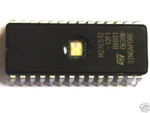Read-only memory
ROM is simply Read Only Memory.
Unlike RAM, ROMs cannot be written to. At one point, ROMs are also typically slower than RAM.
ROMs come in several flavors:
Contents
PROM
PROMs can be programmed ONCE then read many times. If there are any mistakes in the PROM code, the entire chip must be discarded. While PROMs can be read in a normal board, they need to be programmed in a special device (since programming them often requires special voltages).
EPROM
EPROMs can be erased after they have been programmed. Normally there is a small window in the chip in which exposure to UV light will erase the EPROMs programming. EPROMs also need to be programmed in a special programmer.
EEPROM
EEPROMS can be erased electronically, and re-programmed, usually through the application of higher than normal voltage. In modern EEPROMS this is generated internally. Unlike EPROMs, EEPROMS can be re-written in-circuit.
